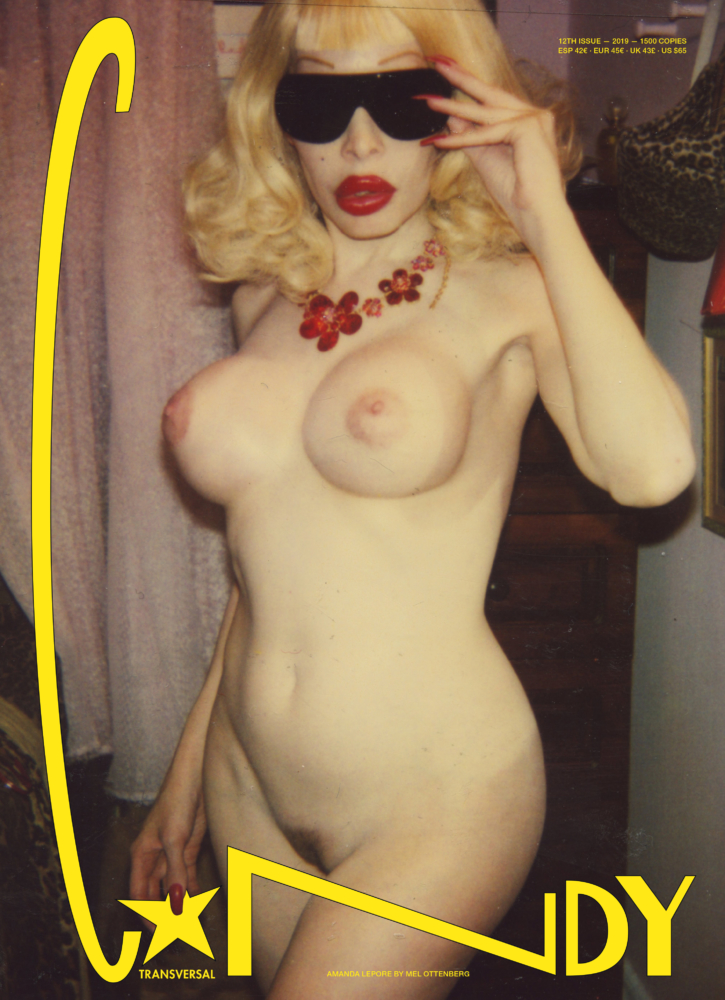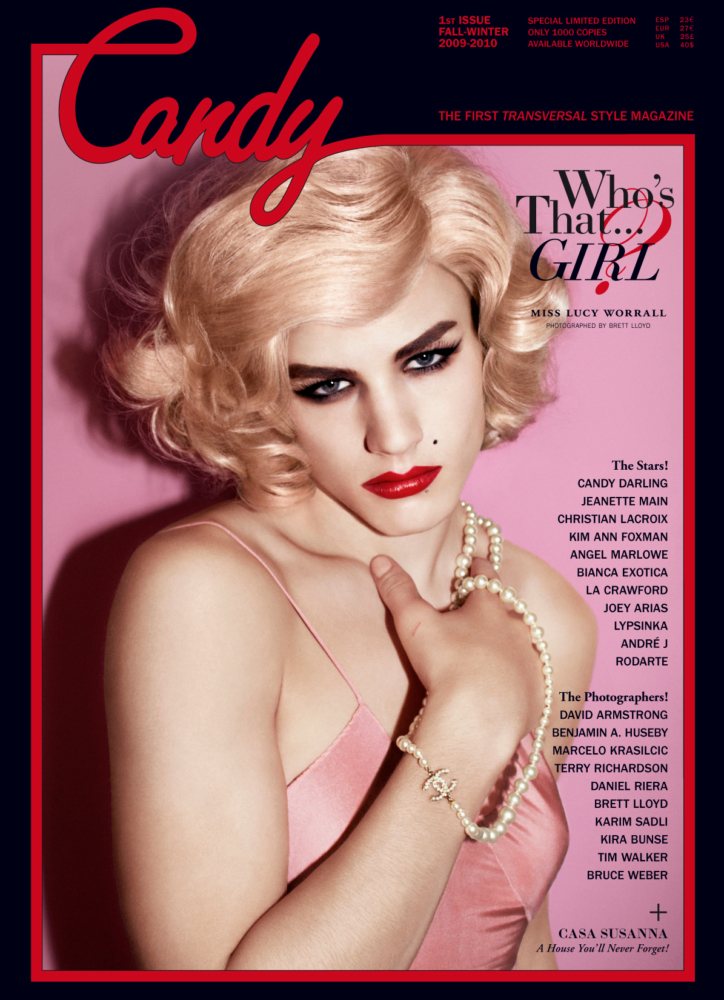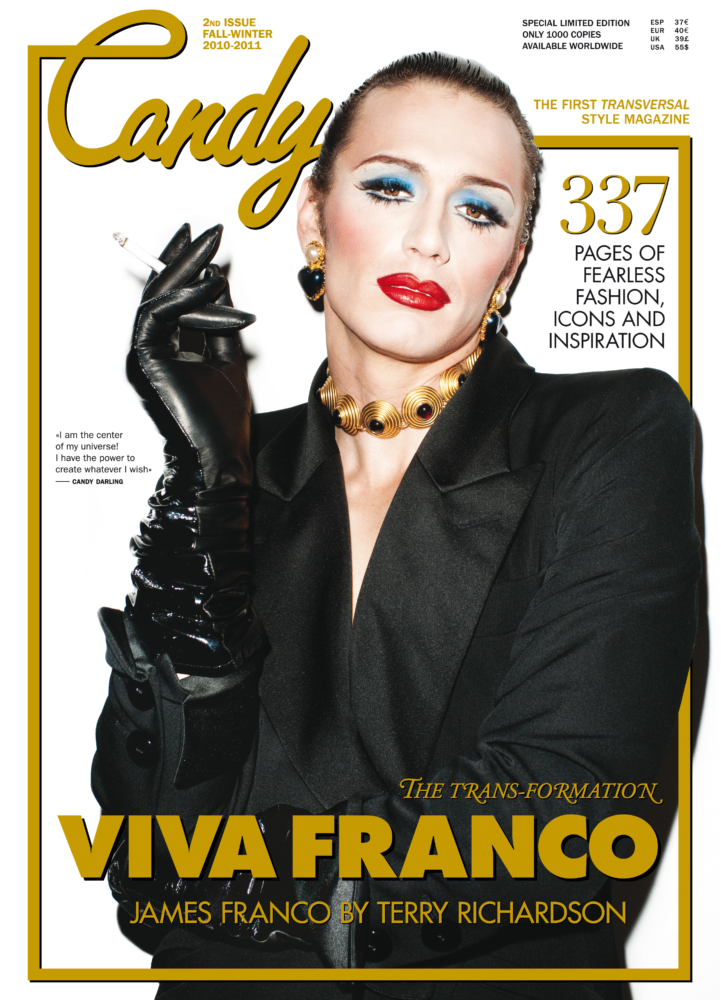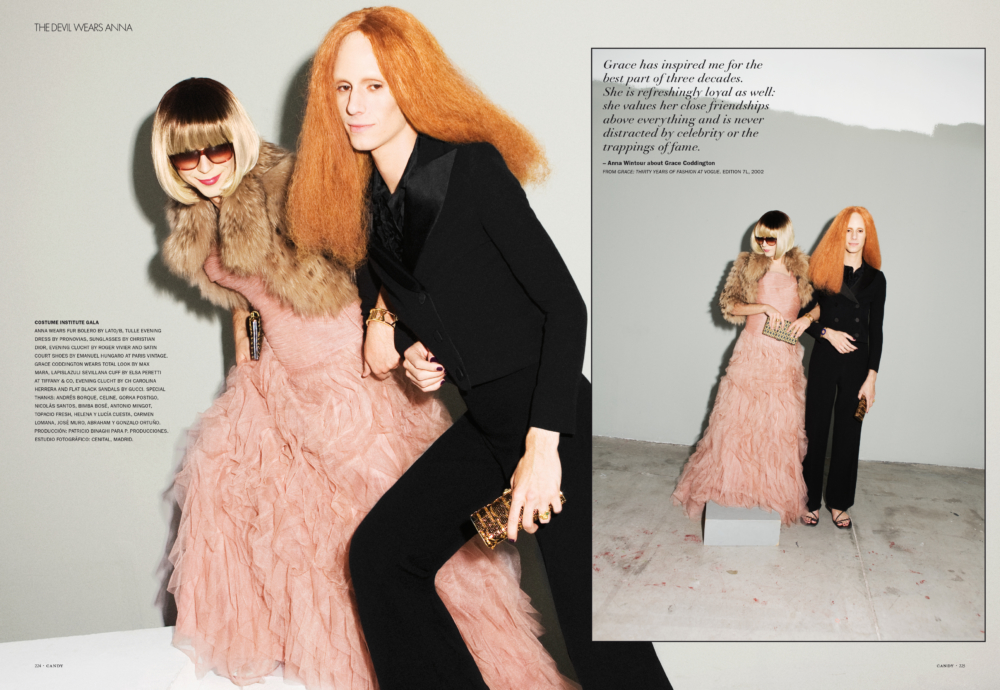How Candy Magazine Shaped the ‘Transversal’ World We Find Ourselves in Today

C☆NDY 12 – AMANDA LEPORE BY Mel Ottenberg.
Publishing magazines is hard. It’s even harder when you’re a one man show responsible for not one, but five publications. Just ask Luis Venegas. For the past decade, the independent publisher has managed to cover fashion, art, dogs, sexy boys, gender, and sexuality with elegance, and wit, all while playing three roles: editor, publisher and creative director. His publications Fanzine 137, The Printed Dog, EY! Magateen, EY! Boy Collection have each cultivated devout audiences, but there’s no doubt that Candy is the reigning queen of his publishing empire. A fashion magazine that celebrates transgenderism, or “the transversal,” as Venegas puts it, Candy has documented the pulse of its community, especially in fashion media, and embellished it with a high sensibility, big name photographers, stylists, and writers, without ever forgetting its core purpose: representation. “It’s kind of a duty, especially for newer generations,” Venegas told Interview. “They need to have the kind of role models they can look up to. It’s important to feel like you’re part of this world.” With Candy celebrating its 10th anniversary of making delicious content, Interview spoke with Venegas about the iconic moments in Candy’s glossy history — the James Franco cover, the Anna Wintour spread — changing the culture, and what the pure celebration of “the transversal” means for a community that’s become increasingly embraced by the mainstream.
———
A Brief Walk Down Memory Lane with Candy’s Sweetest Moments
C☆NDY 1

Luke Worrall by Brett Lloyd.
There were many idols from the past and many stars from the present, and many people who could be—who should be celebrated. That’s how I realized that nothing like Candy had been done before. I wanted Candy to be like a flashy fashion magazine that included everybody — trans, gender non-binary, gender non-conforming. I really wanted people to feel like 1) This is a fashion magazine and 2) It’s really focusing on a series of manifestations, on a series of people.
C☆NDY 2

James Franco by Terry Richardson.
I worked with Mel Ottenberg on this one. We were thinking about the possibility of doing a Hollywood movie star on the cover, and Terry Richardson, who knew everybody, mentioned James Franco. It was at a time when Franco was letting people know that he was interested in the art world. Mel’s styling was great. It was the most remembered thing from that issue. He’s wearing a suit! It’s not like he’s wearing some flashy bra or something. He’s wearing a suit and black gloves. I mean, it’s really severe and austere in terms of what he’s wearing, but at the same time, it’s fabulous.
“The Devil Wears Anna,” C☆NDY 2

Anna Wintour by Brett Lloyd.
For this spread, I thought, “I’m an editor, and what’s the ultimate fantasy of a fashion editor?” It’s Anna Wintour. I was managing and directing the whole shoot. I felt very much like people respected me much more than usual. It was really funny. I sent copies to Anna and Grace Coddington. In fact, Grace herself told me she loved the story, and I asked, “What about Anna?” Grace said, “Well, I’m not so sure she liked it as much as I liked it.”
C☆NDY 8

ROLE MODELS by Mariano Vivanco.
I’ve always loved Vanity Fair. It was the first magazine I ever bought back in Madrid. It was a 1992 issue with Goldie Hawn on top of an elephant on the cover. I’ve always loved their Hollywood cover fold-out. When they put all these models, actors, and actresses together. I felt like it was about time that we try the same thing as they did in Vanity Fair, doing a fold-out cover, and putting all the greatest and most significant trans women in the world. With time, I realized they were also — many of them — women of color. It wasn’t about making a statement. They were really people who others were looking at for inspiration. They all deserved to be together on a cover. Ahead of the 10th anniversary issue, I asked some of the contributors to tell me what the most memorable moment of the magazine was, and many of them, especially trans people, were mentioning that cover.
C☆NDY 12

‘POSE’ stars by Luke Gilford.
Pose is a great and unprecedented show because it’s the first time there’s been a transgender cast leading a show, as well as transgender producer and director Janet Mock. The great thing is Janet was on that cover of the role models, now she’s back again for the 10th anniversary. Just like Candy, there’s been a progression in her career. It’s still powerful to see people of color — especially black trans women — on covers, with transgender black women making up one of the most endangered groups in the trans community.
C☆NDY 7

Lady Gaga by Steven Klein.
Lady Gaga was already one of the biggest stars when she was in the magazine. This was five years ago maybe. I give all the credit to Steven Klein himself. He had been collaborating with Lady Gaga, and when he called me, he said, “Hey, what if we do this thing with your two covers?” It was Marilyn Manson and Lady Gaga, and I feel like both in their own way represent very similar things for people in different generations.” So many of the younger transversal people in the world today have grown up being inspired by the house of Lady Gaga. The older generations always knew she was kind of stealing from David Bowie, from Annie Lennox, and from many others. But, for the younger generations, maybe they didn’t know about David Bowie or Annie Lennox. Instead, they have Lady Gaga. I don’t know if you remember, but during that time, there were rumors that Lady Gaga was trans or something. It was fun to poke at those rumors and show her in a very hybrid way — a little Liza Minnelli in Cabaret, wearing a very Salvador Dalí mustache, and completely naked.
C☆NDY 10

Hari Nef by Nan Goldin.
I’d never had a guest editor before. Hari was starting to do great things as a fashion model, and she was starting her acting career at the time. She’s clever, she’s fun, and she’s beautiful, so why not? It was celebrating what Candy was — taking the magazine to other places just to explore. And, actually having a trans person behind it. We became friends after that, and it became another collectible issue. We had Nan Goldin in there. It had been a dream of mine, for a long time, to have her in the magazine.
———
ERNEST MACIAS: It’s been ten years — congrats! When you first came out with CANDY in 2009, what was the idea?
LUIS VENEGAS: I had been publishing other magazines before, but what I always wanted to do was a fashion magazine. There were so many out there! I didn’t see the point in making another one. I was thinking how important it was to see black models back in the late 60s, and, especially early 70s, in fashion magazines — like when Beverly Johnson was on the cover of Vogue. I was thinking, “What’s missing nowadays in terms of representation?” I realized that the trans world was very connected to fashion because it’s a community that, with what they wear, the makeup and everything — it’s really meaningful and important. But they had no real great fashion magazine. There weren’t any magazines celebrating them.
MACIAS: It’s always been there, right? The trans and queer community inspiring fashion.
VENEGAS: Forever, but I have to say it wasn’t the best moment to start a magazine. It was 2008 when I had the idea, that was exactly when the recession — the big recession — started, so it felt really like the worst moment. It wasn’t the happy 1990s or something, when magazines had huge budgets. I’m an independent publisher. It’s not like I had a huge group behind me taking care of everything. It was really independent, but I wanted it to look the opposite of independent. I wanted it to be like Vogue magazine, actually. I feel like, well, even better than Vogue. [Laughs.]
MACIAS: When you published the first issue, you branded it as “the first transversal style magazine.” What did transversal mean back then, and what does it mean now?
VENEGAS: Well, it’s certainly not the same to be transgender as to be a drag queen, even though many people mix everything. Ten years ago, it wasn’t that clear for most people. The transversal thing for me was the mix of the trans — everything that means change. And then versal — the universal. Putting all those manifestations out there, I was hoping somehow people would understand. When friends heard I was doing this 10th anniversary issue, they asked me what I was going to do to celebrate. I said, “Well, I think I’m going to do the same thing that I’ve always been doing with this magazine — celebrating all of these people and their stories.” It’s still relevant. There are many stories out there that haven’t been properly told yet. There are many great characters to be discovered. I never had a political intention — it’s always been more about celebrating the style and the relevance of the people inside the magazine.
MACIAS: That in itself is a little punk and political.
VENEGAS: It’s true. It wasn’t my intention, but, of course, it could very easily be taken from that side — and it’s completely okay with me. Even though I wasn’t really thinking at the time about representation, for me, it was like, “Okay, this is a great photographer who happens to be transgender.” Somehow people felt like they could approach me. People that maybe had been, I don’t know if I would say rejected, but, maybe, not even considered. They felt like they could ring Candy’s doorbell with a chance to be heard. I’m very happy that we’re talking about this now. It was ten years ago. That’s a lot of time.
MACIAS: It’s wonderful. Just seeing the transformation from the James Franco cover being so explosive, to seeing trans people on TV, red carpets, everywhere really. It does feel like we’ve advanced a few steps.
VENEGAS: Many things have changed in these years. At that time, what you saw in the media, on TV series, in magazines, it was always a very heteronormative thing. This was when RuPaul’s Drag Race had just started. Last year was their 10th anniversary, and it’s great that it has become such a huge show. It feels like even in times when everything seems to be complicated, there’s still progress. We keep breaking barriers and opening our minds to other kinds of masculinity and femininity — whatever those things are. Of course, most of the credit has to be for the real activists who are working for change. I’m happy that from my little publishing house, I’ve been able to help and cultivate that change.






